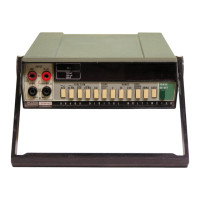8600A
4-62.
Errors in
the display concerning decimal
point
location
and upper or lower
annunciators can be the result
of range
control problems.
A +5V is required from
U8 to
turn on the annunciators.
Decimal point
logic is a positive
pulse output from
U8 occuring at the same time
as the
appropriate strobe
signal. Either STO
or ST7 is selected
by
U16 before
being applied to the display board.
The
digit information
to be presented on the front
panel is
delivered
by U8 in BCD format on lines W,
X,
Y,
and Z.
4-63.
A
malfunction caused by the
display section of
the
circuitry
will generally
cause the
8600A
display
to
indicate the failure
in one of five
ways;
1)
all LED’s are
dark,
2)
one segment
of any one
or all
LED
displays are
dark,
3)
any single LED
display
is dark,
4)
the
numbers
containing
a particular
binary code
(1, 2,
4 or
8)
will not
display or
5)
one digit is brighter
than normal
and all
others are off.
The probable cause for
each
possible
fail-
ure indication is given
below.
4-64.
When all
LED’s are dark, check
for
+5
volts
at
the emitter
of
Q30.
Using
an oscilloscope
check U10
pins
9
through
15,
LED segment
drive
signals, for
a
squarewave
signal alternating
between +3.5
volts and
+0.4 volts.
4-65.
When a segment
of only one
LED is dark the
LED
is the
probable
cause of the failure.
If, however, the
same
segment in all
LED’
s
is out
the particular
segment
drive
signal,
U10 pins
13,
12, 11,
10,9, 15,
or
14
corre-
sponding
to segments
A, B, C, D,
E, F, and
G
respectively,
can be
checked for
the required
voltage change
from
+3.5
volts to +0.4
volts
as the
segment
lights.
4-66.
When one
digit
in the
display remains dark
the
strobe
signal for that
digit
should
be checked. The base
of
Q37
(MSD),
Q29
(2SD),
Q3
1
(3SD),
Q33
(4SD) and
Q35
(LSD) should
go to
+5
volts
as each is strobed on
for
300qs.
4-67.
When
the display
indicates
that one of the binary
codes
(
1
,
2,
4,
or
8)
is
missing; the
bed output from U8
can be observed
at pin 3
1
(1),
32
(2),
33
(4)
and
35
(8).
The
output
at
each
pin should
drop from
+5
volts
to
about
zero
volts
when
that code is
used to produce the
digit
being displayed.
If
the bed
information at U8 is cor-
rect
the probable cause
of
the
failure
is
U10.
4-68.
When one
display
digit is bright and
all others are
off,
the clock oscillator
is
the probable
cause.
Check
the
operation of
U7, U8,
and
the 1 MHz
crystal Yl.
4-12
1/77

